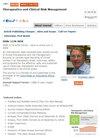Vitamin D and Sarcopenia in the Senior People: A Review of Mechanisms and Comprehensive Prevention and Treatment Strategies
IF 2.8
3区 医学
Q1 Pharmacology, Toxicology and Pharmaceutics
引用次数: 0
Abstract
Abstract: This article reviews the mechanisms and prevention strategies associated with vitamin D and sarcopenia in older adults. As a geriatric syndrome, sarcopenia is defined by a notable decline in skeletal muscle mass and strength, which increases the risk of adverse health outcomes such as falls and fractures. Vitamin D, an essential fat-soluble vitamin, is pivotal in skeletal muscle health. It affects muscle function through various mechanisms, including regulating calcium and phosphorus metabolism, promoting muscle protein synthesis, and modulation of muscle cell proliferation and differentiation. A deficiency in vitamin D has been identified as a significant risk factor for the development of sarcopenia in older adults. Many studies have demonstrated that low serum vitamin D levels are significantly associated with an increased risk of sarcopenia. While there is inconsistency in the findings, most studies support the importance of vitamin D in maintaining skeletal muscle health. Vitamin D influences the onset and progression of sarcopenia through various pathways, including the promotion of muscle protein synthesis, the regulation of mitochondrial function, and the modulation of immune and inflammatory responses. Regarding the prevention and treatment of sarcopenia, a combination of nutritional, exercise, and pharmacological interventions is recommended. Further research should be conducted to elucidate the molecular mechanism of vitamin D in sarcopenia, to study genes related to sarcopenia, to perform large-scale clinical trials, to investigate special populations, and to examine the combined application of vitamin D with other nutrients or drugs. A comprehensive investigation of the interconnection between vitamin D and sarcopenia will furnish a novel scientific foundation and productive strategies for preventing and treating sarcopenia. This, in turn, will enhance the senior people’s quality of life and health.Keywords: vitamin D, sarcopenia, senior people, pathogenesis, comprehensive prevention and treatment strategies
维生素 D 与老年人 "肌肉疏松症":机制与综合防治策略综述
摘要:本文回顾了与老年人维生素 D 和肌肉疏松症相关的机制和预防策略。作为一种老年综合症,肌肉疏松症的定义是骨骼肌质量和力量明显下降,从而增加了跌倒和骨折等不良健康后果的风险。维生素 D 是一种必需的脂溶性维生素,对骨骼肌的健康至关重要。它通过多种机制影响肌肉功能,包括调节钙磷代谢、促进肌肉蛋白质合成以及调节肌肉细胞的增殖和分化。缺乏维生素 D 已被确认为老年人患肌肉疏松症的一个重要风险因素。许多研究表明,血清维生素 D 水平低与肌肉疏松症风险增加有很大关系。虽然研究结果并不一致,但大多数研究都支持维生素 D 对维持骨骼肌健康的重要性。维生素 D 通过多种途径影响肌肉疏松症的发生和发展,包括促进肌肉蛋白质合成、调节线粒体功能以及调节免疫和炎症反应。关于肌肉疏松症的预防和治疗,建议结合营养、运动和药物干预。应进一步研究维生素 D 在肌肉疏松症中的分子机制,研究与肌肉疏松症相关的基因,进行大规模临床试验,调查特殊人群,以及研究维生素 D 与其他营养素或药物的联合应用。对维生素 D 与肌肉疏松症之间相互关系的全面研究,将为预防和治疗肌肉疏松症提供新的科学基础和富有成效的策略。关键词:维生素 D;肌肉疏松症;老年人;发病机制;综合防治策略
本文章由计算机程序翻译,如有差异,请以英文原文为准。
求助全文
约1分钟内获得全文
求助全文
来源期刊

Therapeutics and Clinical Risk Management
HEALTH CARE SCIENCES & SERVICES-
CiteScore
5.30
自引率
3.60%
发文量
139
审稿时长
16 weeks
期刊介绍:
Therapeutics and Clinical Risk Management is an international, peer-reviewed journal of clinical therapeutics and risk management, focusing on concise rapid reporting of clinical studies in all therapeutic areas, outcomes, safety, and programs for the effective, safe, and sustained use of medicines, therapeutic and surgical interventions in all clinical areas.
The journal welcomes submissions covering original research, clinical and epidemiological studies, reviews, guidelines, expert opinion and commentary. The journal will consider case reports but only if they make a valuable and original contribution to the literature.
As of 18th March 2019, Therapeutics and Clinical Risk Management will no longer consider meta-analyses for publication.
The journal does not accept study protocols, animal-based or cell line-based studies.
 求助内容:
求助内容: 应助结果提醒方式:
应助结果提醒方式:


